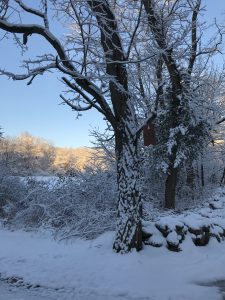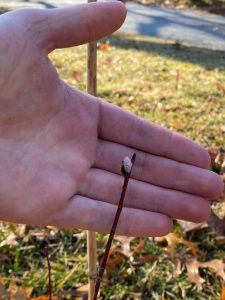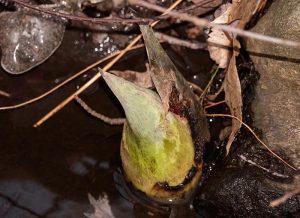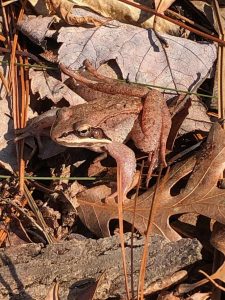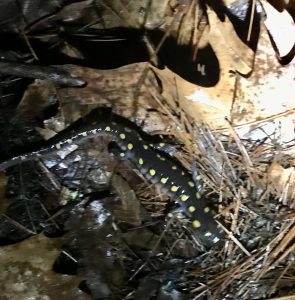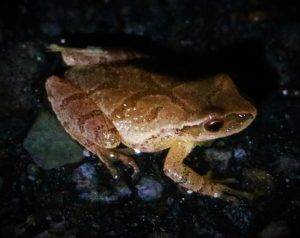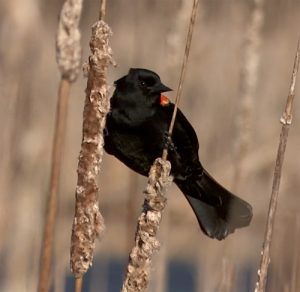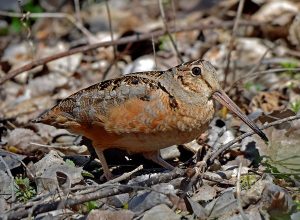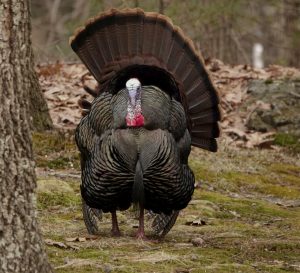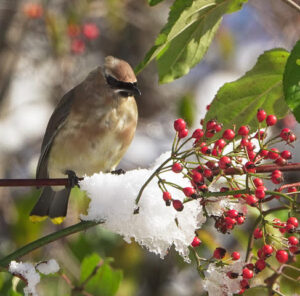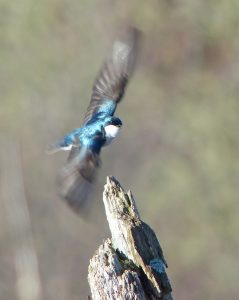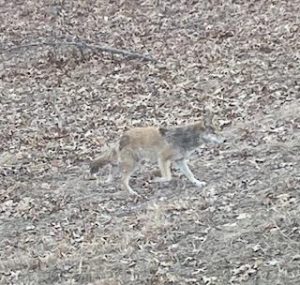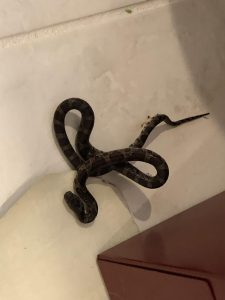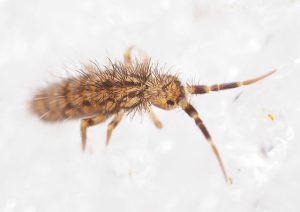Written by Gwyn Loud for the Lincoln Land Conservation Trust. She welcomes your sightings and questions at 781-259-8690 or gwynloud555@gmail.com.
Spring will arrive officially on March 20, the vernal equinox, but signs of the new season are already around us as buds swell, sap flows, birds sing, and hours of daylight increase. Swings in temperature seem to be the new normal and the past month has been no exception, with days in the sixties followed by bitter cold or snow. Climate change is affecting phenology, the timing of annual cycles of plants and animals. To quote from a report by the USGS, “While some species appear to be adjusting to the increase in unseasonal temperatures, drought, and extreme storms that have come with climate change, not all species are responding at the same speed or in the same ways. This can disrupt the manner in which species interact and the way that ecosystems function overall. For example, plants may bloom before butterflies emerge to pollinate them, or caterpillars may emerge before migratory birds arrive to feed them to their young.” On our own properties we can help by growing a diversity of native shrubs, trees, and flowers which bloom at different times.
The landscape is still largely gray and brown, but willows are starting to yellow and garden flowers such as snowdrops are blooming, alongside the early green shoots of daffodils and crocuses. In swamps look for skunk cabbage, which is among a small group of plants which produce their own warm mini-climate in a process called thermogenesis. In this process skunk cabbage increases its intake of oxygen and rapidly burns starch from its massive underground root system, thus creating heat, which it maintains at a steady 72℉, no matter what the outside temperature is. The pollen in the flower provides early food for honeybees, and insects such as carrion beetles, flesh flies, and blowflies are attracted to the skunk cabbage’s fetid carrion-like odor which is intensified by the plant’s warmth. Several species of spiders then prey upon these insects- a whole food chain happening in a small warm space.
On rainy nights in March or April, with a temperature about 40℉, amphibians such as wood frogs, spring peepers, and spotted salamanders emerge from their overwintering places in the woods and make their way to their natal vernal ponds to mate and lay eggs. Even though there was still some snow along roadsides and ice on the ponds, the weather was right on March 7 for the amphibian migration to begin. Observers reported that it was primarily wood frogs and spring peepers crossing roads, with only small numbers of salamanders, so there will certainly be more amphibians migrating over the next few weeks. Soon we can expect to hear spring peepers chorusing and wood frogs croaking (they sound like ducks!). Wood frogs and spotted salamanders stay in the vernal pools long enough to lay eggs and then the adults return to the uplands until next spring. Please drive slowly on wet spring nights to avoid crushing amphibians on the roads; from a driver’s view, salamanders can look a lot like short black sticks.
Avian migrants are arriving, with red-winged blackbirds, brown-headed cowbirds, and common grackles returning right “on time” in late February. American robins are arriving in flocks, some busy in the woods, turning over leaves to find worms and other invertebrates. Killdeer have been spotted in Boyce Field and the Food Project fields and observers have also seen turkey vultures soaring overhead on their way north. I was happy to hear and see an American woodcock soon after sunset in a nearby field. The woodcock, a plump, short-legged and long-billed member of the sandpiper family, has an unusual flight display to attract a mate. He bobs and rocks in a circle in the grass while making a nasal “peent” call, then goes straight up in the air and flies in circles, with air passing over the outer primary feathers making a twittering sound. Making some fast chirps, he then drops to the ground to his original spot and starts the display all over again. Hopefully this will attract a female!
Soon we can expect to see other March arrivals such as Eastern phoebes and tree swallows, followed by many more species in April and May. Eastern bluebirds are already investigating bird boxes and male American goldfinches are showing some yellow as they molt into their striking black and gold breeding plumage. Tom turkeys are stirring about in breeding displays. Other recent avian reports include a belted kingfisher which managed to find food even when ponds were iced over, hooded mergansers on the pond behind St Anne’s, and a flock of cedar waxwings feeding in a homeowner’s crabapple tree. Common mergansers and ring-necked ducks have been on Farrar Pond, and several mute swans have arrived there, preparing to nest. A birder by Flint’s Pond spotted a wood duck, several bufflehead and common golden-eye as well as fifty common mergansers. A bald eagle was seen over Fairhaven Bay, and I had a yellow-bellied sapsucker on my suet feeder for the first time. A Laurel Drive resident hears an Eastern screech owl trilling most evenings, possibly preparing to nest. On a farewell note, our winter residents such as dark-eyed juncos and white-throated sparrows will vanish quietly over the upcoming weeks when they head farther north to nest and raise young.
March is breeding season for many mammals, including chipmunks, woodchucks, otters, mink, and striped skunks. Naturalist Mary Holland writes that, “ Both male and female skunks have been out searching for potential mates for the past month or two, but it hits a fever pitch in March, the peak of their breeding season. If you follow their tracks, be prepared for an extensive outing – they travel as much as two and a half miles a night in their quest for a mate!” Red foxes gives off a scent much like skunks and red foxes and fishers are already giving birth. Coyotes, which bred in February, will give birth to 4-8 pups in April or May and the family will stay together until the young disperse in the fall. Deer are plentiful, as always, and a resident wrote, “Herd of 7 passed thru this afternoon. Eye contact with 2 different ones. They would stamp a foot and I would stamp back (on surface with nice resonant thud). Lasted several minutes before they all moved off”.
We do not expect to see snakes at this time of year, but a condo resident near Farrar Pond was surprised to find one curled up in the family room. It turned out to be a Northern water snake, common in our area. They usually spend the winter brumating in places like muskrat burrows or vole tunnels, emerging in April but apparently the carpeted room was more comfy for this individual! Northern water snakes look dangerous and can bite if handled, but they are harmless, not poisonous. This one was released into the wild by the homeowners. A Cedar Rd. Resident also found a snake recently, a milk snake sunning on the lawn.
Insects and spiders are alive and busy even in this cold weather, as well documented by Norman Levey in photos. Most butterflies overwinter as eggs or pupae, but the mourning cloak is one of three species which overwinters as adult, hiding under bark. The mourning cloak is chocolate brown, with yellow edges and blue dots on the wings and you may find it in the woods at this time of year. Enjoy spring as it unfolds!
To hear the American Woodcock:


